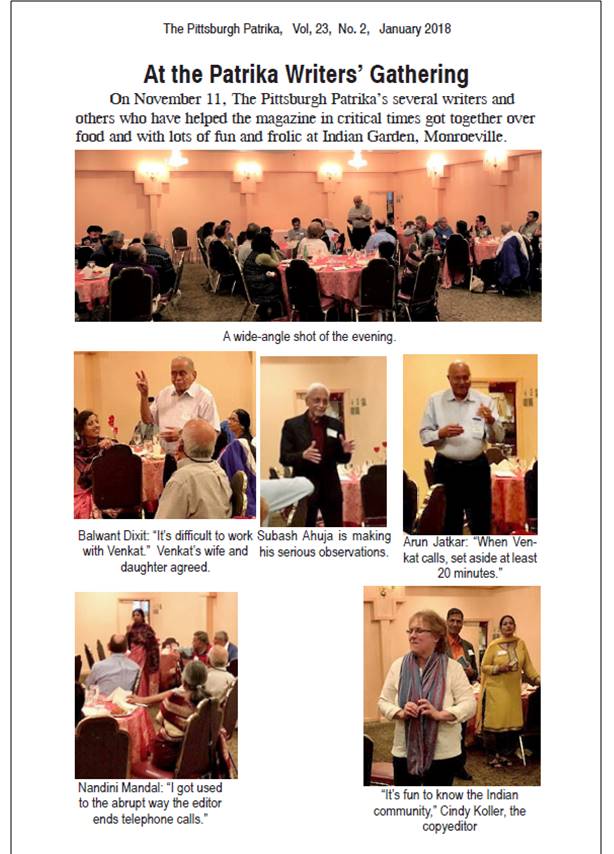Archive for category January 2018
A Level Playing Field for Electing Pennsylvania’s US House of Representatives
Posted by admin in April 2018, January 2018, Past issues on March 2, 2018
By Kollengode S Venkataraman
e-mail: ThePatrika.@aol.com
The US Congress, as required by the US Constitution, has 435 Members in the House of Representatives, elected from 435 electoral districts from 50 states. Each Congressional district must have approximately the same population (~ 720,000 people).
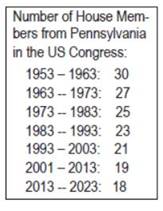
Consequently, states gain or lose House seats depending on the changes in the population determined by the decennial cenÂsus. The population of Pennsylvania relative to the population of the nation has been declining throughout the second half of the 20th century. Hence the number of House seats from Pennsylvania has been shrinking. See the adjacent table. Reference: https://tinyurl.com/Penna-US-House-Seats
Congressmen are elected from each state from “Congressional DisÂtricts,†which are specific geographical areas within the state. The map for each district is redrawn every ten years. The Pennsylvania legislature’s General Assembly (lower house and the senate) in Harrisburg has the authority to redraw the map after each census. However, the governor has to sign off on what the General Assembly proposes.
Pennsylvania is a Moderate State, Relatively Speaking: In elections for the US president and US Senate, the vote split between Democratic and Republican candidates has been between 45:55 or tighter swinging either way. We have voted both for Republicans and Democrats in presidential elections; we have had both Democratic and Republican Governors and US Senators. So, Pennsylvania is a moderate state, relatively speaking.
The 18-member House delegation is skewed towards Republicans. However, if you see the split between the two parties Congressional delegation from Pennsylvania, it is nothing but a scandal. Look at the numbers of GOP and Democratic Congressmen in recent elections from the state:
————————————————————————————————
Election Year and GOP-Democrat Split:
2010: 12-7
2012: 13-5
2014: 13-5
2016: 13-5
————————————————————————————————-
That is, Republicans have 67% of the state’s 18-member Congressional Delegation to the US House, even though the state votes 48-52, swinging either way in presidential and Senate races. The perpetual grip of the Republican majority in the Pennsylvania general assembly garnered such a disproportionately skewed advantage in the US Congress by gerrymandering congressional district maps. They did this by banding and breaking voters identified to vote against them.
Banding: Segments of voters, mostly urban, well known to vote Democratic (for example Blacks, Jews, Asians) would be herded together into very few districts such that in these districts Democratic candidates would win with an 80%-plus majority.
Breaking: Where it suits them, Republicans have drawn the district maps dispersing Democratic voters in a densely populated urban area into multiple Congressional districts thus diluting their effectiveness against them, and gaining a clear advantage for winning in the general elections.
In many districts, once you win in the primary, you coast to victory in the general election. The intra-party primaries are where the battle is won or lost. To know what gerrymandering is, just look at the example of the 7th congressional district, near Philadelphia shown below.


The state’s ~12.75 million population is clustered around urban centers like Philadelphia (6.0 million), Pittsburgh (2.4 million), and Allentown (0.8 million). The state’s population density is shown in the picture below:
The map of the Congressional districts of the last several election cycles is also shown below. The rural districts are large because they are sparsely populated. This way of drawing the districts gave a disproportionate advantage to the Republicans for winning 13 of the 18 House seats from Pennsylvania’s more than 2/3 of the seats.
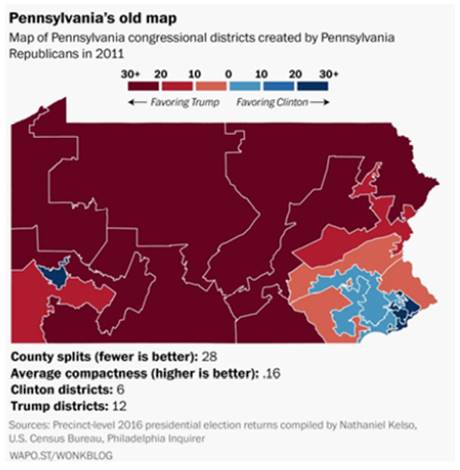
Republicans have been in the majority in the Pennsylvania General Assembly for years. This time, a Democrat (Tom Wolf) is the Governor in Harrisburg. Understandably, the governor did not sign off on the Republicans’ gerrymandered redistricting map. When the issue went to the state Supreme Court the League of Women Voters filed the law suit, the court asked the General Assembly to revise their redistricting map, because the Republicans’ plan was “aimed at achieving unfair partisan gain.” The revised redistricting map of the General Assembly too was not endorsed by the Democratic governor.
So, the state Supreme Court took it upon itself to redraw the congressional districts. With the help of a Stanford University professor, the Court redrew the map, saying the map is “superior or comparable” to all the submitted proposals, and is based on “traditional redistricting criteria of compactness, contiguity, equality of population, and respect for the integrity of political subdivisions.” It is a 4-3 decision in the 7-member state Supreme Court. The court-made map is shown below:
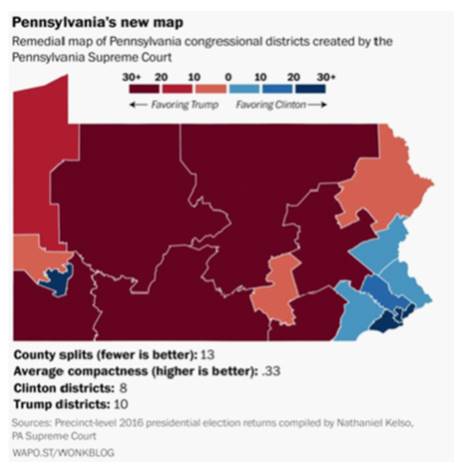
Based on votes cast in the 2016 elections, the new map gives a 10/8 split between the GOP and Democrats compared with the disproportionate 13/5 advantage the GOP now has in the Congressional delegation.
With a more level playing field now imposed by the Pennsylvania Supreme Court, the 2018 mid-term elections to the US Congress in the state become more competitive, representative, and also equitable, in the context of the voting pattern in the state.
We thank the state Supreme Court for correcting the grossly unfair way the GOP-controlled General Assembly in Harrisburg gerrymandered Congressional districts. This and similar decisions in other states correcting the blatant gerrymandering by both parties can finally moderate the partisan deadlock we have been seeing in Washington for the last two decades.
Acknowledgments: The two colored maps of the Congressional districts are from the Washington Post. ♠
Home
The Pittsburgh Patrika Writers Gathering
Posted by admin in January 2018, Past issues on January 9, 2018
And Now, the Turkey Weekend in India, as Covered in The Indian Express
Posted by admin in January 2018, Past issues on January 9, 2018
By K S Venkataraman
India has its own harvest festivals — Pongal, Sankranti, Onam, Naukhai, and Baisakhi, among others — that the urban, English-educated, anglicized  Indians who are completely uprooted from their hinterland, do not know, or do not care for. Lately, the American Thanksgiving bug seems to have bitten them, if you go by The Indian Express’ Lifestyle story (Ref: www.tinyurl.com/India-Thanxgiving-WkEnd). This English daily is published simultaneously in big cities and several second-tier cities.
Indians who are completely uprooted from their hinterland, do not know, or do not care for. Lately, the American Thanksgiving bug seems to have bitten them, if you go by The Indian Express’ Lifestyle story (Ref: www.tinyurl.com/India-Thanxgiving-WkEnd). This English daily is published simultaneously in big cities and several second-tier cities.
In the Indian Express story reproduced below, there is not a single word on the American harvest, or on the Native Americans’ encounters with Whites. I have italicized the phrases to highlight the absurdity in the story. The bold letters are my comments.
“Thanksgiving is a time for family reunions, shopping, merrymaking, feasts and family dinner. People take out time to spend special time to meet near and dear ones and thank them for their kindness. Every year, people all across the world celebrate Thanksgiving Day.
“For Canada it is the second Monday of October and for United States it is the fourth Thursday of November. Other countries like Australia, Grenada, The Netherlands and India also join in the celebration. (Really?)
“This year, the Thanksgiving day will fall on November 23, one day before Black Friday, as per the US’s celebration date.†(Note that the writer puts the cart before the horse.)
Then the story gives a “quick and easy recipe†for roasting Turkey. Turkeys available in India? How many Indian homes have ovens to roast a 20-lb turkey for 4 hours? Then gives a recipe for mash (not mashed) potatoes and cranberry sauce. Where will Indians go for cranberries?
On reading the article, the urban, anglicized Indians in Madras, Bombay, Calcutta, (Chennai, Bengaluru and Kolkata maybe too provincial names for them) will develop a massive inferiority complex on what they are not able to do in India on the Thanksgiving weekend, even though these wannabe-gora Indians are sitting on the very top of the Indian socioeconomic pyramid!!!  ♣
Home
Shivender Nagar’s Journey in Self-Discovery
Posted by admin in January 2018, Past issues on January 6, 2018
Juginder Luthra, Weirton, WVÂ Â Â Â Â Â e-mail:Â Â dolgin1968@gmail.com
“Life is a package deal. No different from a conducted tour. You may not like some parts of the tour or may want more of something else. But you adjust to the chosen package. Not everything in life or your fellow travelers will be perfect. Learn to adjust and compromise.â€
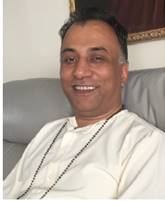 With such and many more examples, Swami Shivender Nagar, often simply called Nagarji, gives discourses on Bhagvad Gita in India and several other countries.
With such and many more examples, Swami Shivender Nagar, often simply called Nagarji, gives discourses on Bhagvad Gita in India and several other countries.
He was born in 1965 in New Delhi. As a young adult, he had the ambition to choose a career in hotel management and settle in Switzerland. Six months into the management course, spiritual inclination directed him to drop the course and join Bible School in Geneva. The studies did not answer all his questions.
He returned to Delhi after one year and started seeking a guru. Fate connected Nagarji with Parthasarthiji, founder of the Vedanta Academy in Lonavala, near Pune, India. Nagarji was one of the eight students in the first class at the Academy. The three-year intensive course was taught in Sanskrit and English. He stayed for one extra year learning from Vedanta-related books in Hindi.
Parthasarthiji asked Nagarji to go to Delhi and start spreading the message. He started giving weekly classes on teachings of the Gita. Mrs. Rita Puri of Pittsburgh happened to be in the audience in Delhi. She invited Nagarji to come to Pittsburgh in 1995 to give discourses in homes and the Hindu Jain Temple. The yearly trip to Pittsburgh has continued, which resulted in him becoming the teacher at the Hindu Jain Temple Summer Camp. About 100 children and counselors receive training through classroom discussions and interactive games. This is followed by a week-long series of evening lectures on different chapters of the Bhagavad Gita at the Temple.
He sprinkles his lectures with easy to remember one-liners:
Seriousness is a sickness.Â
Hard work hardly works. When you enjoy your job it is not work, it is fun. It becomes hard work when you don’t enjoy it.Â
When you demand definite results from your actions, you are pretending to be God.Â
Several families, including Shashi and Ashok Marwaha, in Pittsburgh have hosted Swamiji at their homes. We met him in 1999 in Rishikesh, and have continued our association with him ever since. More people imbibe his messages in their lives.
Nagarji is married to Prema. They have one daughter, Stuti. When asked if his mother lives with him, he quickly answered “No†and after a short pause he continued, “We live with my mother! I have done it all my life.â€
His plan in India is to start Gita Academy in Uttrakhand near Rishikesh. Six-week long residential courses will be offered to individuals between the ages of 18 and 30. In addition to teaching the Gita, he also offers self-improvement courses including how to set goals in life and mind management (including stress, anger etc.). With this much commitment in India, future overseas trips will become less frequent. Summer Camp in 2018 will be held from July 29 to August 4, with lectures at the Hindu Jain Temple held around those dates. He can be contacted here: shivender@hotmail.com.   ♣
Home
In Temple Architecture, Form Needs to Follow Function, but Also Weather Patterns
Posted by admin in January 2018, Past issues on January 6, 2018
By Kollengode S Venkataraman thepatrika@aol.com
With over three million Indians in North America and an overwhelming proportion of them being Hindu, temples are springing up everywhere. With so many temples now in North America, it may be time to reassess how we need to incorporate features suitable to the regional weather patterns in North America.
Organizationally, Hindu temples in North America are structured after American churches with bylaws, membership eligibility, membership dues, elections, and governing bodies (president, chairman, secretary and myriad committees).

In other measures, many Hindu temples here resemble Protestant denominations we see on TV in their perpetual appeal for money — tax deductible, of course — for capital projects one after another. With these things in place, disagreements and fights among members on dogma, rituals, and other practices also are the norm in temples, as in churches here.
However, for cultural, sentimental, and nostalgic reasons, temple managements want to keep the exterior of the temples “Indian†in architecture and artwork. Temples spend enormous amount of time and money, first on “Indianization†projects, and then to
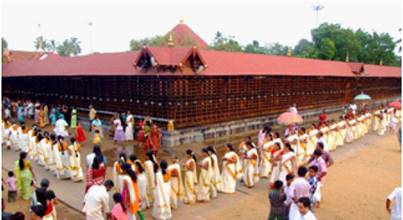
maintain these “Indianized†façades. But as we have seen time and again, this does not always go well, especially in places in the Midwest and Northeast and in Canada with several freeze-thaw cycles in winter, freezing rains, storms that pile 8†to 10†inches of snow on the complex “Indianized†structures.
Cracks in plaster and between brick layers, snow freezing into sheets of ice and inadequate drainage on flat roofs lead to leaks and structural damage. In many temples, these are recurring themes that drain the temple’s time, energy and resources.
Why do temple managements resist adapting temple structures’ basic design to the local
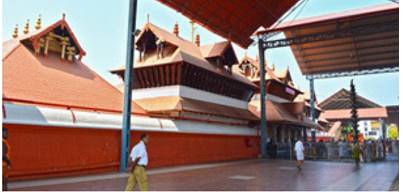
weather patterns? The urge to find costly engineering solutions to retain the Indianized façades with “new & improved†building material is irresistible. But Mother Nature always wins if we do not learn to respect Her ways and adapt ourselves to Her patterns. It is time to look at this with some Vedantic detachment.
Let us look at our personal lives as immigrants here. We take great pride in our — and our children’s — accomplishments in education and careers. Good. But also look at how we individually adapted our personal lives along the way — in our food habits; in worship, prayers, observing festivals in our homes; in walking away from proscribed taboos; on divorce and remarriage; in the choices our children make in their life partners. In
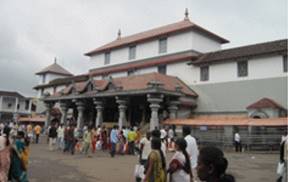
all these, we have crossed every line that was a Lakshman Rekha or taboo just forty years ago.
We have seamlessly adapted our personal lives in so many ways to fit into the ever-changing lifestyles and resources around us. So why do we resist the common-sense-based need to adapt the temple structures to the entirely predictable local and regional weather patterns?
After all, Sthapatis, the traditional Hindu temple architects in India, have understood these local realities through the centuries. That is how and that is why many temples in India have survived for several hundreds of years on very low maintenance, compared to temples built in North America in the last 50 years.
Besides, there is NO ONE Indian Model in temple designs. Consider this: In Kerala and Coastal Karnataka where annual monsoon rainfalls are over 70 to 80 inches, even famous temples rarely have Gopurams/Shikhars we see in other regions. Shrines and exteriors in these temples have simple, sleek, sloping roofs with baked tiles or copper sheets so that minutes after the rainfall, not a drop of water stays on the roof. See the pictures in this article.

Further, every temple in India is built with materials locally available in abundance — like soapstone, sandstones, granites, laterite, and hardwoods such as teak.
Temple managements need to develop guidelines and give them to architects to come up with low-maintenance, yet elegant structures for the sanctums for the deities and the exterior. Maybe we need to “Indian-Americanize†the temples’ exteriors and incorporate architectural features taking into account the regional weather patterns, similar to how we have “Americanized†our Indianness here. Compromises are inevitable.
Only when the temple managements do this, can They focus on the real purpose for building temples — namely, educating our children, organically enlivening the core of the cultural features of our faith (like music and dance), organizing classes on Yoga & Mediation, and preserving our open-architecture philosophical traditions.
Remember, temples in India undertake big-scale renovations and Kumbhabhishekam only once every twelve years. This implies that after such renovations, temples will have no recurring maintenance-related chronic headaches for another twelve years.  ♣
Home
Arts Foundation Honors Artistes & Patrons
Posted by admin in January 2018, Past issues on January 6, 2018
By V Vasudevan, O’Hara, PA   e-mail: Vaidyanathan.Vasudevan@emerson.com
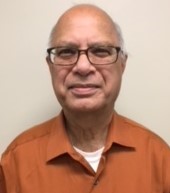 V. Vasudevan, a long-time resident of this area, summarizes the cultural event held in Pittsburgh under the aegis of the Srinivasa Prasad International Foundation for Performing Arts (SPIFPA), instituted in memory of Srinivasa Prasad Gutti by his beloved parents Varaprasad and Parvati Gutti.
V. Vasudevan, a long-time resident of this area, summarizes the cultural event held in Pittsburgh under the aegis of the Srinivasa Prasad International Foundation for Performing Arts (SPIFPA), instituted in memory of Srinivasa Prasad Gutti by his beloved parents Varaprasad and Parvati Gutti.
The Srinivasa Prasad International Foundation for Performing Arts (SPIFPA) organized a nice program on October 14, showcasing some of the talents in South Indian performing arts and honouring artists
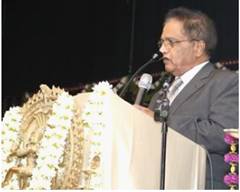
Varaprasada Rao Gutti welcoming the gathering.
and arts patrons. The venue was the auditorium at the Sri Venkateswara Temple. This year’s multi-event program was well-planned, thanks to the attention to detail of the hosts, Varaprasad Rao Gutti and his wife Parvathi.
The program started with Gutti’s opening remarks welcoming the audience and mentioning the mission and objective of SPIFPA in promoting and encouraging South Asian Arts among Indian artists and the mainstream Indo-American youth. The Life Time Achievement Award, Gutti said, is one such form of recognizing patrons and talents.
The invocation pieces were well-done — the Kuchipudi dance rendering of Vande Mataram by Bindu Madhavi Gutti’s students, followed by Manu Narayan singing the American Anthem.

Arpitha Udupa’s recital was a highlight at the program.
In her introductory speech, Parvathi Gutti paid rich tribute to her son, Vasu, his passion for classical music and Kuchipudi and his emphasis that these art forms should become popular among our kids growing up here. The clip showing him performing Entharo Mahanu
Bhavulu was reminiscent of what he aspired to. The foundation is instituted in memory of Srinivasa Prasad. (Editor’s note: Srinivasa Prasad, so full of promise, died in a freak car accident several years ago. He was in his early twenties.)
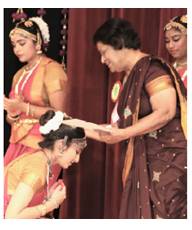
Rajshri Gopal, who started it all decades ago.
The evening’s program with a Karnatic music piece by a teenage ensemble of Sia, Pallavi, Sarang and Rajan showed great promise in terms of precision, poise and dedication.
The Bharatanatyam piece by Mythili Prakash was inspiring and spell-binding. The piece on Shakti brought her a standing ovation. It is no surprise that she received the 2017 SPIFPA Ambassador award for Performing Arts.
Arpitha Udupa’s Premanjali in Kuchipudi style choreographed by Bindu Gutti-Rachuri was well-rendered, highlighting the devotion, love and perseverance of Vasu to this art form.
An All-American dance group of Jaya Mani from Slippery Rock University and Pitt’s Nrityamala showcased the dancers talents and versatility and mastery in the art form. These young dancers come from a wide range of social background and upbringing, thus fulfilling one of the objectives of SPIFPA.
The 2017 Life Time Achievements Award was presented to Revathi Satyu for her contribution of over fifty-three years to Bharatanatyam. Manu Narayan was conferred the award as the Ambassador of Performing Arts for Theater, Broadway Musicals and multi-faceted talents.
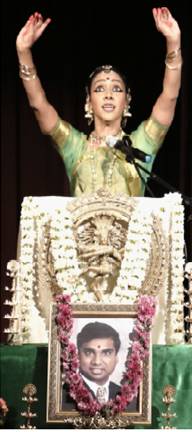
Mythili Prakash at the podium after the award.
Sia Iyer — she is only 12 — received t the Child Vocal Musician Award for her
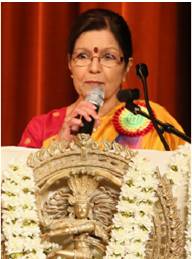
Revathi Satyu at the podium.
commitment, hard work and skills at such a young age. Pallavi Muluk was SPIFPA’s Youth Vocal Musician for 2017 for her talents in Karnatic music, her love of training young children in Pittsburgh. Sarang Mulukutla and Rajan Srimat were SPIFPA Youth Violin and Mridangam Awardees.
Rajshri Gopal lived here in the 1970s through the ‘90s, and is one of the founding members of the SVTemple. With a keen interest in Indian performing arts, she initiated classes for youngsters even before the idea of a temple in Pittsburgh was conceived. Justifiably, SPIFPA felicitated her for her contribution to the temple and Indian performing arts. It was heartwarming to see that she got recognition for her contributions at the SVTemple venue, even though the event was not organized by the temple.
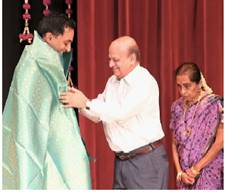
Ashok Madha felicitating Manu Narayan.
Gutti Rao thanked all the artists, the audience and SVTemple for their support in promoting this art form and hoped that this will continue for
years to come.The young artists getting their awards this year, he was sure, will create interest and enthusiasm among our youngsters, one of the main goals for SPIFPA and Vasu. Gutti Rao said SPIFPA would work to establish endowments and recognition awards both in India and the US. ♣
Home
Britain’s Diminished Global Role
Posted by admin in January 2018, Past issues on January 6, 2018
 By K S Venkataraman     e-mail:  The Patrika@aol.com
When the UN was formed at the end of WW-II, the Allied victors dictated the composition of its Security Council. The Security Council was formed with five permanent members with veto power — the US, UK, USSR, France, and China. All except China were among the victors in the War. When India was offered permanent membership in the UN Security Council, Jawaharlal Nehru ceded the membership to China.
 More than seventy years after WW-II, lots of water has flown under London Bridge, and the UK’s clout has been shrinking globally. British cartoonists portray the UK as a vassal of the US. See the cartoon on the side showing the British premier Tony Blair as a puppet of President Bush 43. It is time to seriously question the legitimacy of the UK’s permanent membership in the Security Council with veto power.
More than seventy years after WW-II, lots of water has flown under London Bridge, and the UK’s clout has been shrinking globally. British cartoonists portray the UK as a vassal of the US. See the cartoon on the side showing the British premier Tony Blair as a puppet of President Bush 43. It is time to seriously question the legitimacy of the UK’s permanent membership in the Security Council with veto power.
With its exit from the EU in 2016, the legitimacy of the UK’s disproportionate global presence came into rebuke this November in three elections in one week.
First, the UK saved face by withdrawing from an impending defeat for a seat in the UN’s 15-member body of 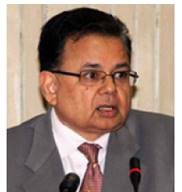 the International Court of Justice (ICJ) in The Hague. The UK’s Christopher Greenwood withdrew from the election and ceded the seat to India’s Dalveer Bhandari (see the picture) after several rounds of deadlocked elections in the UN Security Council. To be elected to the ICJ, candidates need to get a majority votes in both the UN’s General Assembly and the Security Council. Bhandari had an overwhelming support — close to 2/3 of the votes — in all the rounds of voting in the UN General Assembly. In the 15-member Security Council, Bhandari fell short by four votes.
the International Court of Justice (ICJ) in The Hague. The UK’s Christopher Greenwood withdrew from the election and ceded the seat to India’s Dalveer Bhandari (see the picture) after several rounds of deadlocked elections in the UN Security Council. To be elected to the ICJ, candidates need to get a majority votes in both the UN’s General Assembly and the Security Council. Bhandari had an overwhelming support — close to 2/3 of the votes — in all the rounds of voting in the UN General Assembly. In the 15-member Security Council, Bhandari fell short by four votes.
Bhandari was sure to get over 2/3 of the votes in the General Assembly. If this happens, it would be difficult for the Security Council to ignore. Further, after Brexit, even in the Security Council, the UK’s clout has waned. So, Britain ceded the seat to India. For the first time since since its inception in 1945, UK has no representation in the ICJ.
Making matters worse in the same week, the “Great†Britain also lost two high-visibility EU offices. The EU voted to move the office of the European Banking Authority (EBA) out of London to Paris. Similarly, the EU voted that its office of European Medicine Agency (EMA), overseeing Europe’s pharmaceutical industry, will be moved from London and relocated to Amsterdam, Holland.  ♣
Home
Pittsburgh Chinmaya Mission Fundraiser for a Vedanta Center-Temple Complex
Posted by admin in January 2018, Past issues on January 6, 2018
Chinmaya Mission of Pittsburgh had an impressive fundraising event on Saturday, November 18 at the Shriners Center in Cheswick. The evening included a dinner and a collage of Indian dance programs weaving
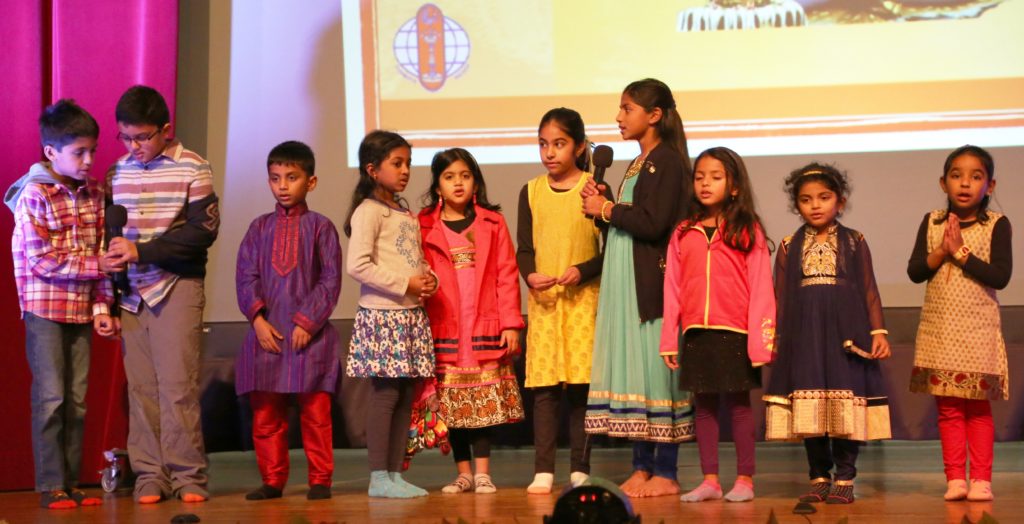
The children of the Chinmaya Bala Vihar reciting a hymn at the beginning.
together Bharatanatyam, Kuchipudi, Kathak, and Odissi styles of dance traditions. The artistes were Atri Nundy (Bharatanatyam) from Buffalo; Kamala Reddy-Rajupet (Kuchipudi); Sudeshna Maulik (Kathak) from Toronto; and Shibani Patnaik (Odissi) from the Bay Area. Tejaswini Rao from Buffalo helped in the choreography, and emceed the dance program.
The dance items, interspersed with speeches from the Chinmaya Organization, gave enough scope for the artistes to display their artistry individually and independently. They also succeeded working together in 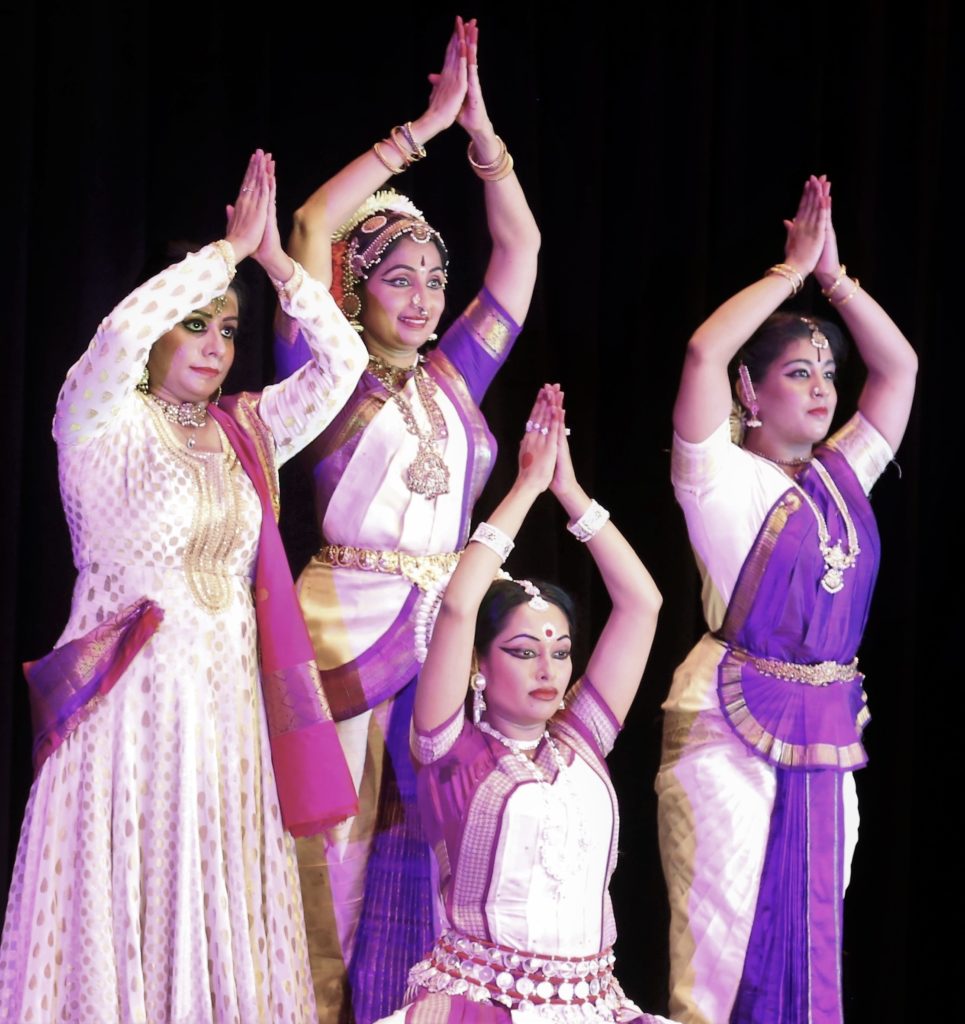 pairs and groups in storytelling, while retaining their individual styles while dancing to the same music. The final piece was a nicely choreographed Tillana, ending in a crescendo of all the artistes dancing together in their own unique styles with good kaala-pramaaNam (timing precision) for the same jatis (rhythm patterns) and music.
pairs and groups in storytelling, while retaining their individual styles while dancing to the same music. The final piece was a nicely choreographed Tillana, ending in a crescendo of all the artistes dancing together in their own unique styles with good kaala-pramaaNam (timing precision) for the same jatis (rhythm patterns) and music.
The focus of the event was fundraising for their Vedanta Center-Temple complex. Over 450 adults and children participated in the fundraiser. They have already acquired land for the place that would include a Shiva Temple, a Vedanta Center, Bala Vihar, and rooms for meetings and classes.
Against their goal of $1.25 million for the evening, they raised as pledges and contribution over $1.1 million — an impressive number by any measure.  Â
— By K S Venkataraman   ♣
Home
Climate Impact of Excessive Consumption of Dairy ProductsÂ
Posted by admin in January 2018, Past issues on January 6, 2018
By Padma Garvey, MD, Hudson Valley, NY
Padma was born in Nellore India and grew up in Pittsburgh. She earned her medical degree from the University of Pittsburgh in 1992. She is a full-time gynecologist in the Hudson Valley area, married to her physician husband for 25 years. She has two kids in college. She practices yoga and is dedicated to teaching people about the benefits of a plant-based diet. She has a website (www.drpadmagarvey.com).
Editor’s Note: This is a complex topic on many measures. As the author herself notes in the short write-up below, “[G]lobal hunger has very little to do with lack of food and more to do with a lack of access to it,†which means a lack of affordability for the working poor in a country like India. While malnourished infants and young children from poorer families in India do not get even one banana a day or one glass of milk or yogurt a day, upper income families are submerged in dairy products, with cheese being the latest entrant in India. Still the author’s point is valid that these upper income Indians will be helping themselves and the environment by consuming less dairy products.
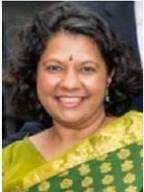 A few years ago, I went to India with my mother for a visit.  On that visit, I noticed an alarming number of obesity clinics, heart centers, fast food restaurants, and of course pollution. I also noticed that milk consumption had increased substantially, especially in the forms of butter, ice cream, and cheese. I started to wonder how the dietary habits of one billion people could impact the environment, agriculture, and animal welfare. I wondered what had to be done to keep up with the rising demand for milk. How many cows did it take? How much hormonal stimulation did it require? How much machinery was necessary? And what was happening in America where diary consumption is one of the highest in the world?
A few years ago, I went to India with my mother for a visit.  On that visit, I noticed an alarming number of obesity clinics, heart centers, fast food restaurants, and of course pollution. I also noticed that milk consumption had increased substantially, especially in the forms of butter, ice cream, and cheese. I started to wonder how the dietary habits of one billion people could impact the environment, agriculture, and animal welfare. I wondered what had to be done to keep up with the rising demand for milk. How many cows did it take? How much hormonal stimulation did it require? How much machinery was necessary? And what was happening in America where diary consumption is one of the highest in the world?
India sprang from an ancient civilization that reaped enormous benefits from the domestication of cattle and the consumption of milk. The unprecedented access to a highly nutritious food was no doubt the reason for an emergence of a religious and moral philosophy whose central God figure was a cow herder. It was no doubt the reason for the adoration and the worship of the cow, and the commitment to protect it. Well-fed people can make the moral leap to advocate nonviolence against animals and a vegetarian lifestyle. It is no wonder, then, that India is where the first notions of moral and sustainable eating came to be.
Nowadays, global hunger has very little to do with lack of food and more to do with a lack of access to it. We can and do make enough food to feed everyone.  We are trying to feed the world on the backs of animals by eating their meat and drinking their milk. The idyllic image of the happy cow, herded by beautiful maidens along green grasses is not how most cows, in America or in India, find themselves. Dairy farming is a round-the-clock operation where animals are housed in small cubicles, attached to milking machines for hours at a time. There is no joy in their lives. They are carrying the weight of the world’s bellies on their udders and are a major contributor to green-house gases.
The countries with the highest rates of breast-, prostate-, colon-, and uterine-cancer have the highest rates of dairy and meat consumption. The resources required in land, water, and fuel are enormous. This places an undue burden on the environment as well. It might be time for Hindus to, once again, take a moral leap and abstain from dairy consumption as a way of protecting the cow and our planet.  ♣
Home
The Madhavs Bid Goodbye to Pittsburgh
Posted by admin in January 2018, Past issues on January 6, 2018
By Sudha Pandalai, Cincinatti, OHÂ Â Â e-mail:Â Â sppandalai@yahoo.com
Editor: Sudha P. Pandalai grew up in the Pittsburgh Metro area. Her family and the Madhavs have been friends for many years.
 Dr. Ashok and Mrs. Shobha Madhav, long-standing members of the Pittsburgh Indian community, recently moved to Silver Springs, MD to begin a new chapter in their lives. Their friends in Pittsburgh will miss them but wish them well in this next phase.
Dr. Ashok and Mrs. Shobha Madhav, long-standing members of the Pittsburgh Indian community, recently moved to Silver Springs, MD to begin a new chapter in their lives. Their friends in Pittsburgh will miss them but wish them well in this next phase.
In the early days of the Indian community in southwestern Pennsylvania, the Madhavs enriched the lives of their colleagues and friends in ways large and small. They have a diverse circle of friends from their fifty-years of living in the Pittsburgh area.
Both have been highly active at the Sri Venkateswara Temple and other local religious and cultural institutions through the years, and have been strong enthusiasts of classical Indian performing arts (both dance and music). Since the 1970’s they have encouraged many artists, both those established, and those who were just beginning their careers, through arranging concerts and hosting them.
Additionally, Dr. Madhav has contributed to the Karnatic music repertoire by composing kritis in all of the 72 Melakarta (parent) ragas. His deep grasp of music theory and history, in topics ranging from Karnatic music Janaka and Janya ragas, to Thaats in Hindustani music, and to taalas, has made Dr. Madhav sought-after by many professionals, and students of music, wanting to clarify finer points in Indian classical music. (Editor’s Note: In the very first issue of the Patrika, Dr. Madhav reviewed “Purushâ€, a dance program with an all-male ensemble, led by Bharatanatyam Maestro C. V. Chandrashekhar and Kathak Maestro Birju Maharaj)
Mrs. Madhav has been a vital part of the community. She is noted for her skill in public speaking, and through the years, she has been a popular emcee at various functions. These include public programs at the Sri Venkateswara Temple and private functions such as many Arangetrams performed by dance students in the area.
With the move further east, the Madhavs will enjoy being closer to their daughter Anita, her husband Jim and their children; and being nearer to their son Nitin. In October close to fifty friends of the Madhavs gathered at the Tamarind Restaurant in Green Tree to bid them farewell. Their friends in Pittsburgh thank them for their years of friendship, wish them well in their new home, and promise to visit them in DC. ♣
Home
US Economy: President Trump’s First Year after Eight Years of the Obama Presidency
Posted by admin in January 2018, Past issues on January 6, 2018
By Kollengode S Venkataraman      e-mail:  ThePatrika@aol.com
On faith, economics and politics, it is futile to persuade people to change their opinion. This is because to varying degrees, these opinions are based on beliefs. But we can discuss people’s assertions on economics putting them in context so that readers can come to their own conclusions. So, while I am not trying to persuade Mr. Koul to change his opinions, I do put his observations on the US economy under Donald Trump’s first year in the White House in the context of Obama’s eight-year presidency.
Mr Koul’s assertion on the Dow Jones’ new peaks during Trump’s first year is correct if you take the one year of Trump’s residency in isolation. But when you look at the D-J numbers since Obama’s time, we can place the D-J numbers under Trump in context. See the plot below. When Obama won the election in 2008, the D-J average was around 9000. During his presidency, it steadily rose from 9000 to almost 19,000 in the long-haul, with a few inevitable short-term hiccups. In Trump’s first year, this trend only continued.

On unemployment: Again, Mr. Koul’s numbers are correct if you take Trump’s first year in isolation. But here is the trend on unemployment in the last nine years. Plot below. When Obama was elected, unemployment was over 7%, and went up to 10% in his first year. Then, it continuously dropped from 10% in January 2010 to 4.8% when Obama’s presidency ended in November 2016. Even a die-hard Republican would agree that an eight year trend of a steady drop in unemployment is significant for any president.
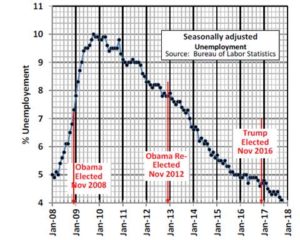
Now consider GDP growth during Trump’s first year in office. Again, Mr Koul’s claims are correct if you take Trump’s first year in isolation. But below is the plot of the quarterly GDP growth during the last 12 years:
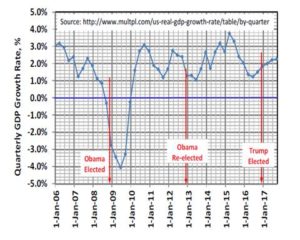
During George Bush’s last three years in office, the GDP growth rate fell from 3% in Jan 2006 to negative growth (-2.8%) by the time Obama was elected. In Obama’s first year, it hit a low of -4%. But since 2010, GDP growth has been in positive territory. For four quarters under Obama, the GDP grew at over 3%; and well above 2% for over 4 years in his 8 years in office. Under Trump’s first year in the White House, this trend continues.
To summarize, Mr. Koul’s claims on the D-J numbers, unemployment and GDP growth numbers during Trump’s first year in office are correct — and also quite noteworthy — only if you consider the Trump presidency’s first year in isolation. However, if you consider Trump’s first year in office in the context of Obama’s earlier eight years in office, the numbers and trends under President Trump are a continuation of the trend set by the Obama presidency. Good for President Trump. And good for the citizens of the USA.
We wish Trump the very best in the remaining three years of his presidency.    ♣
Home
A Supporter of President Trump Responds to the Lead Article in the July issue
Posted by admin in January 2018, Past issues on January 6, 2018
Hiralal Koul, MD, Johnstown, PAÂ Â Â e-mail: hkfxguts@yahoo.com
 Editor’s Note: Mr Hiralal Koul, MD (now retired), a resident in Johnstown, PA, took umbrage at the lead article titled “Unsettling Early Days of Trump’s Presidency†in the July issue of the magazine. Mr Koul, after a few acerbic e-mails, gave his permission to publish his response, provided we “publish [his] letter in its ENTIRETY (& not an editorialized version).â€Â So, here is Mr. Koul’s response in its entirety, without changing one word, one letter, or one comma.
Dear Editor:
 1) Defense, Security & Terrorism. a) ISIS/Daesh (that Obama called a JV team) & “we’ll try to contain itâ€; has Largely been Vanquished & holds NO land anymore. This is something, Obama failed to accomplish, in Nine years. b) Following Trump’s historic trip & Speech to Saudi Arabia; it’s the FIRST TIME, in over 70-years (since SA’s independence), that this Country (the Heart of Islam), BROKE ranks with Qatar, for supporting/Financing Terrorism. Qatar, has been playing both sides, for years. Thanks to Obama Administration; it’s HOME to the largest US Military base. This is the country, where Obama Exchanged, Top FIVE Taliban Commanders (from Gitmo), for the Traitor, BO Bergdahl (referred to as a good soldier by Susan Rice-former NSA). Suggest you read more about this issue & BenGhazi Betrayal, by former Navy Seal, Tej Gill (aka- Tenminder singh, first Indian born US Navy Seal). Gill, has accused, Obama / Clinton Administration personally, of Murdering the American Marines in BenGhazi. Suggest, you also, “look intoâ€, how the “Muslim Brotherhood†in the Obama/Clinton Administration; orchestrated, the exit of “Tulsi Gabbard†(the only practicing Hindu Congresswoman from Hawaii). This position was later filled with Keith Ellison, (a Muslim Convert from Minnesota); an ardent supporter of “Sharia Lawâ€. Furthermore, you may want to “Look intoâ€, who the former, disgraced DNC- chair (Debbie Wasserman), hired as a New IT, personnel; who was just arrested, before fleeing US for Pakistan!
1) Defense, Security & Terrorism. a) ISIS/Daesh (that Obama called a JV team) & “we’ll try to contain itâ€; has Largely been Vanquished & holds NO land anymore. This is something, Obama failed to accomplish, in Nine years. b) Following Trump’s historic trip & Speech to Saudi Arabia; it’s the FIRST TIME, in over 70-years (since SA’s independence), that this Country (the Heart of Islam), BROKE ranks with Qatar, for supporting/Financing Terrorism. Qatar, has been playing both sides, for years. Thanks to Obama Administration; it’s HOME to the largest US Military base. This is the country, where Obama Exchanged, Top FIVE Taliban Commanders (from Gitmo), for the Traitor, BO Bergdahl (referred to as a good soldier by Susan Rice-former NSA). Suggest you read more about this issue & BenGhazi Betrayal, by former Navy Seal, Tej Gill (aka- Tenminder singh, first Indian born US Navy Seal). Gill, has accused, Obama / Clinton Administration personally, of Murdering the American Marines in BenGhazi. Suggest, you also, “look intoâ€, how the “Muslim Brotherhood†in the Obama/Clinton Administration; orchestrated, the exit of “Tulsi Gabbard†(the only practicing Hindu Congresswoman from Hawaii). This position was later filled with Keith Ellison, (a Muslim Convert from Minnesota); an ardent supporter of “Sharia Lawâ€. Furthermore, you may want to “Look intoâ€, who the former, disgraced DNC- chair (Debbie Wasserman), hired as a New IT, personnel; who was just arrested, before fleeing US for Pakistan!
For the first time, since Independence, a $50-Million, package to Pakistan was blocked by the Trump administration; : This is in Sharp contrast, to the $15-Million cash, Hand Carried by Hilary Clinton, as secy: of State (in Obama administration), for the Pak: Military for preventing firebombing a US convoy carrying aid to Afghanistan.
Since Trump inauguration, illegal Border crossings have dropped by 70%, along our Southern border & ZERO, along the Pakistan/ Kashmir border!. 6) First Time, since NATO was created; it’s Non US members; have agreed to pay up their (2% of that country’s GDP) & Incorporate, anti-terror, measures into NATO, Charter. In the process, US taxpayer (I hope you are one); will NOT be burdend with it. it!
2) Economy, Jobs, GDP: a) GDP, has increased from 1% (in Obama administration to 2.6%, now). b) Unemployment has dropped to 4.5%, lowest in about 20-years. c) Average wages are up by 2.5%. d) Consumer spending has increased. e)Trade deficit, has decreased, albeit modestly, first time in over 35-years. f) stock market has recorded 50-NEW records, since Election Night, a 3500-points, increase in DOW & infused 3-Trillion Dollars, into the US Market. These numbers are from the Article “Trump effectâ€; by CNN-money (no friend of Trump).
3) Foreign & Domestic investments, into US: Carrier, Ford, GM, Fiat Chrysler, Toyota & Mazda, while, BMW’s plant in SC, will become the Largest plant in the World. 4) Soft Bank, Foxconn, Mahindra, TransLux (china), will invest in US; about 3-Trillion Dollars. 5) For the first time, since the Birth of this Nation; US is becoming an Energy Exporter! 6) VA reform & incompetent employees can be fired (& have been), since VA was created.
Finally, I’d take issue with your spin of “Unsettling Days†& argue, Future for me (in my adopted Country); is far more Optimistic, Safe, Confident & Bright. That said; I’m under no illusion that “Trump Hatersâ€, would accuse the president (Trump), of Destroying the livelihood of Cancer Doctors; should he discover, a Cure for Cancer tomorrow!
Yes, you may publish this letter in its ENTIRETY (& not an editorialized version).   ♣
Home
Shruthi Sivakumar: “How I Aced the SAT and ACT Tests?”
Posted by admin in January 2018, Past issues on January 6, 2018
 Editor’s Note: Recently, Shruthi Shivkumar who attends Peters Twp. High School, aced the SAT and ACT tests. Here she answers to our questions about her preparation and success.. Shruthi in the photo below is with her parents Shivkumar Anumalachetty and Narmada Sriraman with sparklers during Deepavali. Â
Editor’s Note: Recently, Shruthi Shivkumar who attends Peters Twp. High School, aced the SAT and ACT tests. Here she answers to our questions about her preparation and success.. Shruthi in the photo below is with her parents Shivkumar Anumalachetty and Narmada Sriraman with sparklers during Deepavali. Â
- How did you get started preparing for the SAT exams?
I started with Mukund Uncle’s SAT prep class at the S V temple. His free weekly group classes gave tips and strategies for taking the test.
- What goal did you set for yourself before you took the tests?
I set my goal for the real SATs for “above a 1500,†or a little over 750 in each section. I was ready to take the test multiple times.
- Did you go to any prep and coaching classes?
Mukund uncle referred me to Goldstein Test Prep. I had one-on-one classes with Mr. Goldstein because students aiming high have individual classes with Mr. Goldstein himself. They were incredibly helpful.
- How many AP classes are you taking?
Several, between the 10th and 12th grades in Biology, Physics I, US History, Psychology, Language, Statistics, Calculus, Chemistry, Economics, Environmental Science, Literature, French.  My school does offer many AP classes.
- How early on did you start your regimen of preparation?
I started when I was in the 10th grade.
- How did you prepare? Did you set aside a predetermined time daily?
I set a goal for what I wanted to accomplish and not in what time. For example, I’d say, “OK, today I’m going to finish sections 1 and 2 of this practice test.†As I got closer to the deadline, I’d make sure to always finish within the time constraint for that particular section.
- How many hours a day did you study for the test on an average?
Setting a strict “per day†time frame may not always work for busy students. Closer to the deadline, I spent three or four hours a week taking practice tests. I wouldn’t advise much intense preparation until you’re very close to taking the test. Doing practice tests closer to the actual date just kind of mentally prepared me.
- The essay test is different since you need to think on your seat on a topic you don’t know ahead of time. Is the written essay compulsory?
The written essay is optional for most schools, but I’d say do it anyway just because you might change your mind about applying to that one school that does require it. Most colleges know that it’s not a completely accurate reflection of your writing skills anyway. It doesn’t factor into your whole SAT/ACT score- you get a separate essay score. Having an advanced or AP Language/Literature course beforehand will definitely prepare you for the essay. Try looking at those kind of review books.
- How did you prepare for the written essay in the exam hall? Â
I spent a few minutes, maybe 3 to 5, prewriting. Generally, writing teachers say to spend about 5-10% of your time prewriting. It’s good way to make sure you cover all the points you want to cover.
- Did you prepare for acing the exam? Or was it a situation in which you knew you did very well, but did not expect a clean sweep?
I definitely, definitely did not expect to ace it when I took it. I was hoping for at least a 1490-1500 so that I’d be happy for a first shot, but could then retake the test. I thought a perfect score was completely out of the question… … and for sure, I honestly couldn’t believe it when I got it.
- Is 3 to 4 months prep adequate for the English vocabulary section?
The best preparation for the English test is just reading. Read nonfiction, fiction… anything. The best way to familiarize yourself with the English language is to just constantly be exposed to different usages of it. I also write a lot, so English wasn’t so bad for me. Also, reading helps you for college after the tests are over.
- What single piece of advice would you give a student preparing to take this exam next year?
Don’t spend way too much of your time preparing for it until maybe two to three months before the test. Only then heavy practice benefits you, and not earlier. Earlier exposure is always good. But get to the “6 hours a week routine†when you’re close to the actual test.
- Who motivates you to be a high achiever?
Working hard is instilled in me by my parents. I’m thankful for that.
- Do you want to add anything else?
Mr. Goldstein told me to think of the SAT/ACT as a game. After a certain point, it is more about strategy and test-taking skills. Test makers try to trip you to make mistakes. So, make sure to practice those skills.
Don’t spend way too much time preparing for these tests where it takes time away from your extracurriculars. The admissions process is holistic: colleges want people, and not robots. Standardized test scores are not trophies; they are a sort of roadblock to get over. Getting very high scores doen’t get you a “golden star†at super selective schools. But having a 75th percentile score for a specific school will mean you’ve surpassed one of the many obstacles to get in. Hope this helps. ♣
Home
Globalization, NOT Something New — Part II
Posted by admin in January 2018, Past issues on January 6, 2018
By Kollengode S Venkataraman
As presented in the first part of this article in the last issue, the industrialized West, after the Industrial Revolution, had unbridled advanÂtages for over 250 years with their superior grasp of S&T (science and technology) and industrial and military power. They fully exploited these advantages through colonization. But this wave has run its course. S&T is now accessible to any society willÂing to invest and work at it. China has already emerged as a global economic and military power. China has recaptured its glorious past with vengeance. InÂdia is still emerging, and may take another 20 to 30 years to regain its foothold.
Having lost the unrestrained advantages they had, England, the US, and other European nation-states find it difficult to adjust to the new realiÂties. The US sees globalization as a contagious disÂease it needs to inoculate itself against.
The industrialized societies first created an uneven playing field slanted in their favor and exploited global human and natuÂral resources for over two centuries. Now they are pleading for a level playing field, when the playÂing field is slanted against them for reasons that are of their own making. Savor these ironies here:
-  In June 1987, President Ronald Reagan stood in front of the ninety-mile long Berlin Wall and addressed the crowd, calling the Soviet Union’s President Mikhail Gorbachev to “Tear down this wall!†After thirty years, US President Donald Trump now declares, “We WILL build this wall†along the 1700-mile long US-Mexico border.
-  Britain, starting as traders, colonized the Indian subcontinent, parts of Asia and many parts of Africa in bits and pieces and declared, “The sun never sets on the Empire.†The empire imploded after WW II, even after winning the war. Today, Britain, only a hundred years ago such an overweening and arrogant empire, is reduced to a state in which she is even afraid of foreigners, not from her erstwhile colonies, but from Europe — from Poland, Hungary, Latvia, Lithuania – who come to work and live in the UK. So, it left the EU and shrank to the island nation-state that it was centuries ago. Now, the sun barely shines over London’s cloudy skies.
This is the new reality. Individuals are always motivated by their insecurities (real or imagined), the need for power/control, greed and profit. Nation-states in times of war unleash a potent amalgam of these motivating ingredients on citizens, coalescing them around the idea of patriotism and nationhood. They also add a good dose of xenophobia, prompting citizens to respond to their diktat, often with disastrous consequences. Just look at these bone-chilling casualty numbers of WW II:
World Population in the 1940s: 2,300 million (today, it is over 7,000 million).
Deaths in WW II:
Military deaths: 23 million.
Civilian deaths: 30 million.
Civilian deaths (famine/disease): 25 million
Total: 78 million, or
A whopping 3.4% of the world population then
Total Deaths (military personnel, civilians, and war-created famine) in different countries:
USSR: 26 million;Â Â Â Â Â Â Â Â Â Â Â Â China: 18 million
Germany: 7 million; Â Â Â Â Â Â Â Â Poland: 6 million
S.E. Asia: 3.5 million;       India, 2 million  (India as a colony, and South East Asia had no direct stake in the war)
UK: only 0.45 million; Â Â Â Â Â Â USA: only 0.42 million
Source: WikiPedia
In the infamous Bengal Famine 1943 during Churchill’s regime 2.5 million Indians died out of malnutrition, and malaria famine, total neglect of sanitation, and also on account of war time agrarian policies of the British colonial occupiers in India. Millions of Indians died in the several famines during the British colonial rule of ~150 years. These are well-documented.
Trying to find military solutions, as has been the practice in the last 200 years, would be disastrous today. Now, 50% of the world’s population lives in crowded urban areas, compared to 19% in 1900 and 30% in 1950. In North America and Western Europe, 70% of their populations lives in urbanized areas.
Today we live in a world interconnected by communications, trade, and manufacture. Multinational companies operate all over the globe through their supply chains for raw materials and components, not just for computers and consumer electronics and appliances, but also for important medicines, and critical chemical intermediates that go into manufacture of those pharmaceuticals. This fact alone is a soft but effective deterrent, better than military alliances, against large-scale wars. Consider these:
- Instantaneous, inexpensive communication with an active social media offsets the stranglehold of governments’ propaganda machines and global media houses to sway public opinion.
- Businesses operate in plants in every region taking advantage of low labor costs, tax regimes, even lax environment laws. The self-interest of businesses against uncertainties in war can prevent military conflicts.
- Population migration is the norm of our time, globally, regionally, or even within the large nation-state like China, India or Russia.
- Ethnic groups in every region and in every country realize that they depend on other ethnic groups for their survival and self-preservation, both locally and globally. In the US, as in India, different ethnic/migrant groups in different regions control whole trades. New York City would collapse without its large swath of immigrant population. Farming and slaughterhouse businesses for meat and poultry in North America is simply not possible without low-paid migrant Latino workers from “South of the Border.â€
The converging self-interest of these diverse groups locally, regionally, and globally, offers a counterbalancing force for managing global conflicts without the need for large-scale wars. ♣

